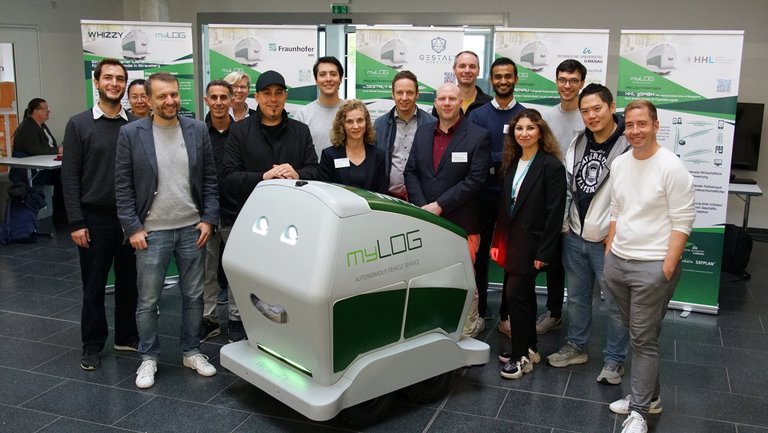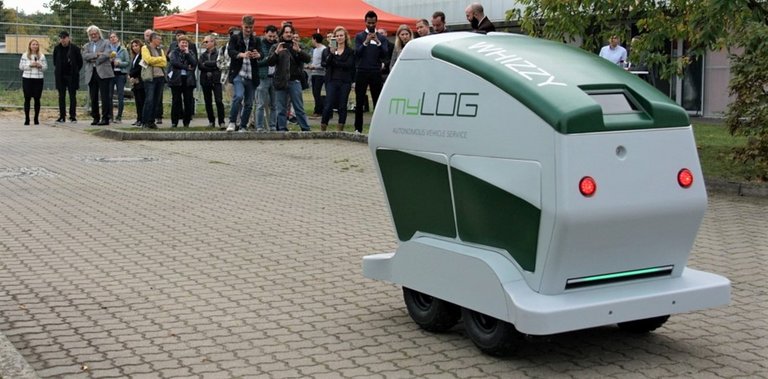How can stationary retail trade in rural areas be strengthened in order to hold its own against large online delivery services? This question is currently being addressed by researchers at the Process Optimization Group at TU Ilmenau. As part of the myLOG - MOL project, they are working with partners to develop a delivery system with autonomous transport vehicles that is based on the optimal use of state-of-the-art 5G technologies and makes it possible to deliver goods significantly faster and cheaper than with conventional delivery services. The shopping and delivery robot "Whizzy" is to deliver goods from local retailers to customers in Strausberg as early as 2024. It has already been presented to the public.

Retailers in smaller towns in particular have been suffering from declining sales for years. Consumers are ordering their goods via more and more online platforms and having books, electronic goods or groceries delivered. It is not only the large online platforms that are competing with retailers in the city centers. Increasingly, sports and fashion brands are also selling their goods in their own online stores. This trend has been significantly reinforced by the Corona crisis: according to a study by the Ifo Institute, people in Germany are becoming more and more accustomed to buying clothing or household goods online, which is increasingly leading to the desolation of city centers.
In order to counteract this development and strengthen the competitiveness of the retail trade against online retailing, the TU Ilmenau, Interlink GmbH, LandLogistik GmbH, the Fraunhofer Heinrich Hertz Institute (HHI), the HHL Leipzig Graduate School of Management and Gestalt Robotics GmbH have joined forces under the leadership of STIC Wirtschaftsfördergesellschaft Märkisch-Oderland. Together with the district of Märkisch-Oderland (MOL), they are developing a novel logistics system based on the 5G mobile communications standard. The idea and concept for myLOG -MOL emerged from the ZIM network "Autonomous Logistics in Rural Areas " (AULORA), explains Prof. Pu Li, head of Group and expert in process optimization at TU Ilmenau.
What is special about the concept is that several suppliers, such as grocery stores, pharmacies, rehabilitation providers, bookstores, textile stores, shoe stores, restaurants and other selected users, jointly use a local autonomous logistics system to fulfill the individual wishes of various customers.
Faster and cheaper delivery than via traditional online trading
Businesses can offer their products online via the myLOG app:
As soon as a registered user has triggered his or her order via the app, the ordered goods are delivered within the city area with the help of the shopping robot - virtually in real time. The customer receives a signal via the app that "Whizzy" is at the door and can pick up the goods from the rover's compartment after entering a code number.
In doing so, the 5G network allows a completely new technological approach: "The 5G technology enables us to outsource the complex calculations that the rover needs for orientation and movement to the cloud," says Prof. Li. In this way, the short distances mean that the participating companies can deliver much faster and presumably more cheaply than conventional online retailers, thus exploiting their greatest strength: their proximity to customers. The 5G network guarantees not only real-time communication, but also safe, reliable operation of the autonomous delivery robots.
Diverse challenges in technical implementation
However, the technical implementation of the project initially presented the project partners with a variety of challenges beyond the functional vehicle control system: Together, they had to master path recognition and energy management and ensure that the transport vehicles found their way and avoided obstacles. To this end, Prof. Li and his team not only developed and tested the driving functions and planned optimal routes, but also developed an image processing solution that would enable the robot to safely navigate the walkways:
Only with a well thought-out solution for environment perception can such a system be operated economically.
In addition, sensors networked via mobile radio still have to be installed at some intersections so that the delivery robot can also access information outside its field of vision and "Whizzy" can drive safely and accident-free through Strausberg. The autonomous delivery robot completed its first test drive in October on the premises of STIC-business development company. For the first field test in the coming year, 15 to 20 retailers in Strausberg are to be won over. Some have already registered their interest.
"In Thuringia and in the city of Ilmenau, too, we need forward-looking innovations for the logistics infrastructure to support the crisis-stricken retail sector," Prof. Li is convinced:
With our holistic approach, we can serve as a pioneer in the development of new concepts and technical solutions, and with the high visibility of the model project, we can provide impetus to make logistics in rural areas more economical and make regions with low population density more attractive for companies - while at the same time maintaining and even improving the quality of life of the resident population.
The project is part of the 5G implementation funding under the 5G Innovation Program of the German Federal Ministry of Digital Affairs and Transport (BMDV) and will be funded with a total of 3.7 million euros for three years.
Find out here how "Whizzy" navigates through the STIC campus.


